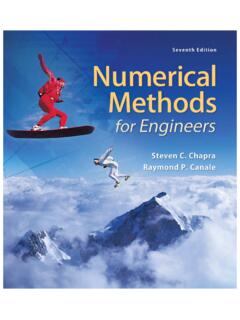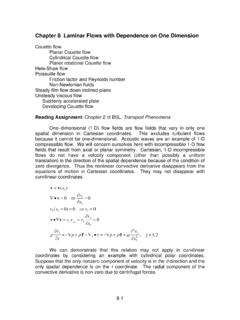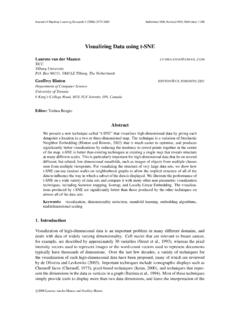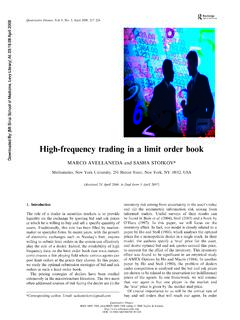Transcription of Strong and Weak Forms for One-Dimensional Problems
1 3. Strong and Weak < Strong >FormsStrong > for < Strong >One-DimensionalStrong > < Strong >ProblemsStrong > In this chapter, the Strong and weak < Strong >FormsStrong > for several < Strong >One-DimensionalStrong > physical < Strong >ProblemsStrong > are developed. The Strong form consists of the governing equations and the boundary conditions for a physical system. The governing equations are usually partial differential equations, but in the < Strong >One-DimensionalStrong > case they become ordinary differential equations. The weak form is an integral form of these equations, which is needed to formulate the nite element method. In some numerical methods for solving partial differential equations, the partial differential equations can be discretized directly ( written as linear algebraic equations suitable for computer solution).
2 For example, in the nite difference method, one can directly write the discrete linear algebraic equations from the partial differential equations. However, this is not possible in the nite element method. A roadmap for the development of the nite element method is shown in Figure As can be seen from the roadmap, there are three distinct ingredients that are combined to arrive at the discrete equations (also called the system equations; for stress analysis they are called stiffness equations), which are then solved by a computer. These ingredients are 1. the Strong form, which consists of the governing equations for the model and the boundary conditions (these are also needed for any other method);. 2. the weak form.
3 3. the approximation functions. The approximation functions are combined with the weak form to obtain the discrete nite element equations. Thus, the path from for the governing differential equations is substantially more involved than that for nite difference methods. In the nite difference method, there is no need for a weak form; the Strong form is directly converted to a set of discrete equations. The need for a weak form makes the nite element method more challenging intellectually. A number of subtle points, such as the difference between various boundary conditions, must be learned for intelligent use of the method. In return for this added complexity, however, nite element methods can much more readily deal with the complicated shapes that need to be analyzed in engineering design.
4 To demonstrate the basic steps in formulating the Strong and weak < Strong >FormsStrong > , we will consider axially loaded elastic bars and heat conduction < Strong >ProblemsStrong > in one dimension. The Strong < Strong >FormsStrong > for these < Strong >ProblemsStrong > will be developed along with the boundary conditions. Then we will develop weak < Strong >FormsStrong > for these < Strong >ProblemsStrong > and show that they are equivalent to the Strong < Strong >FormsStrong > . We will also examine various degrees of continuity, or smoothness, which will play an important role in developing nite element methods. A First Course in Finite Elements J. Fish and T. Belytschko # 2007 John Wiley & Sons, Ltd ISBNs: 0 470 85275 5 (cased) 0 470 85276 3 (Pbk). 42 Strong AND WEAK < Strong >FormsStrong > FOR < Strong >One-DimensionalStrong > < Strong >ProblemsStrong > . Strong form Weak form (Chapter 3) (Chapter 3).
5 Discrete equations (Chapter 5). Approximation of functions (Chapter 4). Figure Roadmap for the development of the nite element method. The weak form is the most intellectually challenging part in the development of nite elements, so a student may encounter some dif culties in understanding this concept; it is probably different from anything else that he has seen before in engineering analysis. However, an understanding of these procedures and the implications of solving a weak form are crucial to understanding the character of nite element solutions. Furthermore, the procedures are actually quite simple and repetitive, so once it is understood for one Strong form, the procedures can readily be applied to other Strong < Strong >FormsStrong > .
6 THE Strong FORM IN < Strong >One-DimensionalStrong > < Strong >ProblemsStrong > . The Strong Form for an Axially Loaded Elastic Bar Consider the static response of an elastic bar of variable cross section such as shown in Figure This is an example of a problem in linear stress analysis or linear elasticity, where we seek to nd the stress distribution s x in the bar. The stress will results from the deformation of the body, which is characterized by the displacements of points in the body, u x . The displacement results in a strain denoted by e x ; strain is a dimensionless variable. As shown in Figure , the bar is subjected to a body force or distributed loading b x . The body force could be due to gravity (if the bar were placed vertically instead of horizontally as shown), a magnetic force or a thermal stress; in the < Strong >One-DimensionalStrong > case, we will consider body force per unit length, so the units of b x are force/length.
7 In addition, loads can be prescribed at the ends of the bar, where the displacement is not prescribed; these loads are called tractions and denoted by t. These loads are in units of force per area, and when multiplied by the area, give the applied force. x p(x) b(x+ x 2). p ( x + x). u (x ) u( x + x ). A(x) b(x). t x x=l x=0. Figure A < Strong >One-DimensionalStrong > stress analysis (elasticity) problem. THE Strong FORM IN < Strong >One-DimensionalStrong > < Strong >ProblemsStrong > 43. The bar must satisfy the following conditions: 1. It must be in equilibrium. 2. It must satisfy the elastic stress strain law, known as Hooke's law: s x E x e x . 3. The displacement eld must be compatible. 4. It must satisfy the strain displacement equation. The differential equation for the bar is obtained from equilibrium of internal force p x and external force b x acting on the body in the axial (along the x-axis) direction.
8 Consider equilibrium of a segment of the bar along the x-axis, as shown in Figure Summing the forces in the x-direction gives . x p x b x x p x x 0: 2. Rearranging the terms in the above and dividing by x, we obtain . p x x p x x b x 0: x 2. If we take the limit of the above equation as x ! 0, the rst term is the derivative dp=dx and the second term becomes b x . Therefore, the above can be written as dp x . b x 0: 3:1 . dx This is the equilibrium equation expressed in terms of the internal force p. The stress is de ned as the force divided by the cross-sectional area: p x . s x ; so p x A x s x : 3:2 . A x . The strain displacement (or kinematical) equation is obtained by applying the engineering de nition of strain that we used in Chapter 2 for an in nitesimal segment of the bar.
9 The elongation of the segment is given by u x x u x and the original length is x; therefore, the strain is given by elongation u x x u x . e x : original length x Taking the limit of the above as x ! 0, we recognize that the right right-hand side is the derivative of u x . Therefore, the strain displacement equation is du e x : 3:3 . dx The stress strain law for a linear elastic material is Hooke's law, which we already saw in Chapter 2: s x E x e x ; 3:4 . where E is Young's modulus. 44 Strong AND WEAK < Strong >FormsStrong > FOR < Strong >One-DimensionalStrong > < Strong >ProblemsStrong > . Substituting ( ) into ( ) and the result into ( ) yields . d du AE b 0; 0 < x < l: 3:5 . dx dx The above is a second-order ordinary differential equation. In the above equation, u(x) is the dependent variable, which is the unknown function, and x is the independent variable.
10 In ( ) and thereafter the dependence of functions on x will be often omitted. The differential equation ( ) is a speci c form of the equilibrium equation ( ). Equation ( ) applies to both linear and nonlinear materials whereas ( ). assumes linearity in the de nition of the strain ( ) and the stress strain law ( ). Compatibility is satis ed by requiring the displacement to be continuous. More will be said later about the degree of smoothness, or continuity, which is required. To solve the above differential equation, we need to prescribe boundary conditions at the two ends of the bar. For the purpose of illustration, we will consider the following speci c boundary conditions: at x l, the displacement, u x l , is prescribed; at x 0, the force per unit area, or traction, denoted by t, is prescribed.














